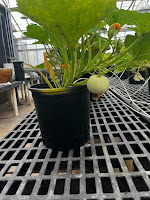On our last stop on day 9 on the Summer Ag Tour, we visited the University of Illinois’ and their ACES (Agricultural, Consumer, and Environmental Sciences) department. We met up with Ms. Emily who took us to Turner Hall. Turner Hall is where a lot of the crop and natural resources and environmental science majors have their classes. Turner Hall is connected to the multitude of greenhouses they have on campus. Ms. Emily passed us off to Ms. Rose who gave us a tour of these greenhouses. In these greenhouses they mostly grow corn, soybeans, and sorghum, which are staple crops up here in the Midwest. They have 60,000 square feet of greenhouse space which they use to house, study, research, and experiment with many different types of plants. They have integrated in using pest control through a biological control (biocontrol) method. Biocontrol can be described as using beneficial insects, pathogens, or viruses to control unwanted pests, weeds, and diseases. In the instance of Illinois State, instead of using pesticides on their plants, they use a predatory mite to kill whatever pest may be infecting their plant. Different mites are used to attack different pests. These mites use their new home to breed and reproduce, creating a whole ecological inside a plant. One of the plants we were looking at had Cryptolameus- a mite in the pupae stage living on the plant, it looks like a white puffy substance. However, the mites need to be added at an interval in order to prevent inbreeding and competition amongst the mites. The whole reason they switched to using biocontrol through the predatory mites was because of a resistance issue they had in the past. They had a resistance issue with spider mites and the spray they were using to try to get rid of the mites was ineffective. Therefore, they tried the biocontrol which over time solved that problem. Which led them to using biocontrol as their main resistance preventative method. These mites are not harmful to humans, and they do not affect the consumption of the produce. 

Next, Rose took us to their Aquaponics greenhouse. The plants grown in here are used for the cafe' on campus, as well as performing different experiments on the different crops. They grow a whole variety of produce such as blackberries, strawberries, tomatoes, peppers, leafy greens, and a whole variety of herbs. Some of these systems are connected to the fish they have in this room- koi fish and tilapia. The water from the fish tank is connected to the plants. The water from the fish tank cycles upward and then drips down onto the plants, this water is rich from the manure excreted by the fish that provides essential nutrients to the plants. The water is then taken in by the plants and the excess water or water filtered by the plants then runs down into a tub underneath. That tub of water is then recycled back into where the fish are.
After the aquaponics, Rose led us to their pumpkin project greenhouse. Here they experiment with diseases surrounding pumpkins. They also strive to make their pumpkins the best and most attractive looking as they can, attempting to achieve that desirable jack-o-lantern look. Rose left us with a fun fact about Illinois and pumpkin production as they are the largest pumpkin producing state in the United States!

Then, Rose took us to their Regulated Projects greenhouse. Here, they focus on transgenics- altering the genetic material or DNA of an organism. They do this to help focus on problems such as climate change, herbicide resistance, and increased crop production. Rose shared a story with us about how they recently took DNA from a beetroot and injected those genes into some corn they were growing. The corn, when fully matured, was a magenta color. They studied the color to see if that had any affect on the production of the crop, such as light efficiency.
The last couple of greenhouses we saw were a part of the Botanical Garden. There, it consisted of a fern room, cactus and succulent room, sub-tropical room, rainforest room, tropical room, and one large conservatory.After that Rose passes us back off to Emily where she talked to us about their school and the ACES program. The ACES building was actually built to replicate that of a grain bin! The ACES program offers 18 agricultural related majors as well as certification programs. ACES is huge on research, experiential learning, and internship opportunities. Students get a lot is hands on experience (experiential learning) from the numerous amounts of farms and other plants, cafes, centers, and labs they have on campus. Within these hands-on opportunities, students can conduct their own experiments and research, which was discussed a lot within the tour with Rose. ACES also offers study abroad programs. Emily was telling her about her experience with just coming back from an abroad trip as a chaperone to Panama where they toured a pineapple plantation, cacao plantation, and a horse farm. The University of Illinois offers over 1,000 student programs, but 30-40 of them are ACES related organizations. Emily stressed the amount of diversity not only within their campus as a whole, but in ACES as well, with everyone being able to find something that they love.









.jpg)



















No comments:
Post a Comment